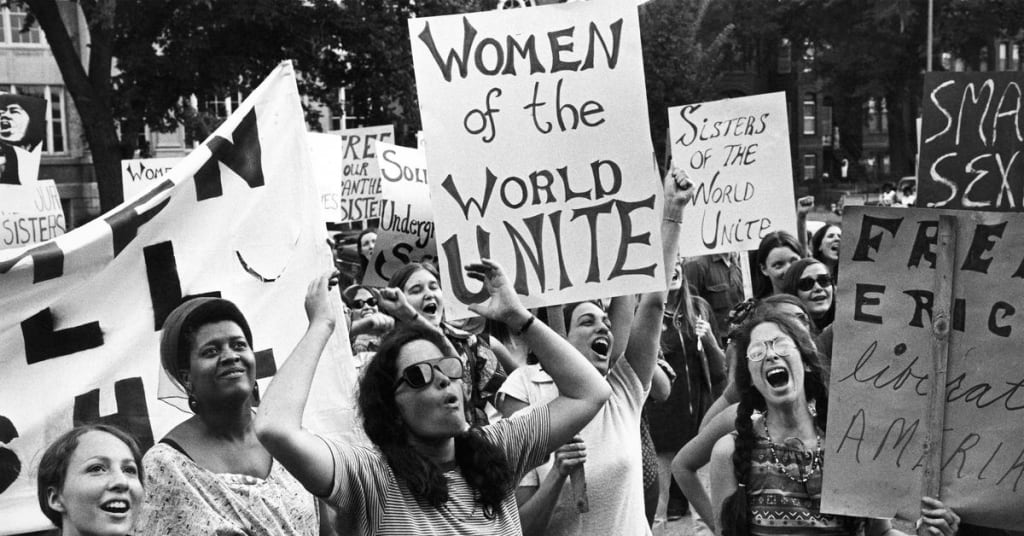Feminism Perspective through Time
Fashion has always been a reflection of societal values and norms, and the influence of feminism on this dynamic industry has been profound. This article explores the journey of feminism and its impact on fashion, tracing the evolution from early suffragette style to the modern era of exclusivity and empowerment.

In the late 19th and early 20th centuries, as the suffragette movement gained momentum, women began using fashion as a tool for political expression. The suffragette style was characterized by symbolic colours, such as purple, white, and green, representing dignity, purity, and hope. Clothing became a canvas for activism, merging fashion with a powerful political statement.
One of the most distinctive features of suffragette style was the use of specific colours and symbols. Purple, white, and green became the official colours of the movement, each carrying a symbolic meaning. Purple represented dignity, white symbolized purity, and green stood for hope. These colours were incorporated into clothing, sashes, and accessories as a way for suffragettes to visually communicate their cause.
Suffragettes often adorned themselves with sashes and ribbons in the movements. These accessories were worn over dresses and coats, making a bold and visible statement. The combination of these symbolic colours and accessories helped suffragettes stand out during protests and public events, turning everyday fashion into a form of political expression.
Style was practical and purposeful. Women involved in the movement recognized the need for clothing that allowed them to actively participate in protests and rallies. The attire was designed to be more functional than the restrictive fashions of the time, featuring looser silhouettes and comfortable fabrics that facilitated movement.
In their pursuit of equality, suffragettes also adopted elements from men's fashion. Some women wore tailored jackets and hats reminiscent of men's styles, challenging traditional gender norms. This borrowing from men's fashion was a deliberate choice to emphasize women's capability to engage in political and social spheres traditionally dominated by men.
Fashion played a crucial role in creating a visual identity for the movement. Uniformity in dress reinforced a sense of unity among suffragettes, helping them forge a collective identity. This shared visual language helped communicate the seriousness of their cause and conveyed a message of strength and determination left a lasting legacy in the history of feminist fashion. Beyond its immediate political impact, it set a precedent for using clothing as a tool for activism. The idea that fashion can be a powerful means of expression and a way to communicate social and political messages has endured throughout the decades, influencing subsequent waves of feminist movements and their approaches to style.
The suffragette style remains a powerful example of how fashion can be both a personal and political statement, demonstrating the intersection of clothing and activism in the pursuit of social change.
In 1920s witnessed a seismic shift in societal norms, and fashion followed suit. The flapper style emerged, liberating women from restrictive corsets and introducing shorter hemlines. This era marked the beginning of women's liberation, as they embraced more comfortable and daring clothing, signalling a departure from traditional gender roles.
World War II brought about a practical shift in fashion. With men at war, women entered the workforce in unprecedented numbers, influencing a utilitarian approach to clothing. Utility fashion emphasized functionality, reflecting women's new-found roles and responsibilities. Pants became a symbol of empowerment as women took on jobs traditionally held by men.
The 1960s and 70s saw the rise of the second wave of feminism, sparking a cultural revolution. Fashion became a battleground for equality as women rejected stereotypical roles. Miniskirts and pantsuits became symbols of defiance, challenging societal expectations. Designers like Yves Saint Laurent played a pivotal role in introducing androgynous styles that blurred gender lines.
Yves Saint Laurent, the iconic fashion designer, made significant contributions to the world of fashion, but his views on feminism have been a subject of discussion. On one hand, he was known for empowering women through his designs, challenging traditional gender norms with pieces like the tuxedo jacket for women. This was a groundbreaking move in the 1960s, reflecting a feminist spirit by giving women a sense of confidence and power through clothing.
However, Yves Saint Laurent's personal life and statements have also been criticized. Some argue that his views on women were contradictory, as he made statements that could be perceived as objectifying or limiting. It's important to consider the context of the time in which he lived and worked, as societal attitudes toward gender roles and feminism have evolved.
In essence, Yves Saint Laurent's impact on feminism is complex. While his designs often empowered women, his personal beliefs and statements may not align perfectly with modern feminist ideals.
The 1980s marked a period of power dressing, where women sought equality in the workplace. Sharp-shouldered suits and bold accessories became the armor of the working woman. This era witnessed the fusion of femininity with authority, as women embraced fashion to assert themselves in male-dominated professional spheres.
Late 20th century and early 21st century ushered in the third wave of feminism, characterized by an emphasis on intersectionality and inclusivity. Fashion responded by celebrating diversity in body types, ethnicities, and gender expressions. Runways became platforms for challenging beauty standards and promoting a more inclusive definition of femininity.
The advent of social media in the 21st century revolutionized the fashion industry. Feminist voices found new avenues for expression, challenging beauty norms and promoting body positivity. Online activism became a powerful force for change, holding the fashion industry accountable for representation and ethical practices.
The relationship between feminism and fashion is a dynamic and evolving narrative. From suffragette statements to modern inclusivity, fashion has mirrored the progress of women's rights. As we move forward, it is crucial to recognize the power of fashion in shaping cultural attitudes and to continue advocating for a more diverse, equitable, and empowering industry.
In 2023, feminism continues to evolve, reflecting the changing dynamics of society and addressing new challenges.
Modern feminism places a strong emphasis on intersectionality, recognizing that women's experiences are shaped by various intersecting factors such as race, class, sexual orientation, and ability. Activists strive to create an inclusive movement that addresses the unique struggles faced by women with diverse identities.
Social media and digital platforms play a central role in contemporary feminist activism. Movements like #MeToo and #TimesUp have gained momentum, providing a space for survivors to share their stories and hold perpetrators accountable. Online activism has also facilitated global solidarity and the rapid dissemination of feminist ideas. There is a growing focus on promoting body positivity and challenging beauty standards. Feminists advocate for the acceptance and celebration of diverse body types, pushing back against unrealistic and harmful ideals perpetuated by the media and the fashion industry.
Feminist activism in the workplace has intensified, with a focus on closing the gender pay gap, promoting equal opportunities, and combating workplace harassment. Initiatives to break down barriers for women in leadership roles and traditionally male-dominated industries are gaining traction. Feminists continue to advocate for reproductive rights, including access to safe and legal abortion, comprehensive sex education, and affordable healthcare. Issues related to reproductive justice are seen as integral to women's autonomy and bodily autonomy.
There is a growing intersection between feminism and environmentalism, often referred to as eco-feminism. Activists highlight the impact of climate change on women, particularly in vulnerable communities, and emphasize the need for sustainable and equitable solutions. Feminism in 2023 is increasingly inclusive of LGBTQ+ issues. Advocates work to ensure that feminist spaces are welcoming and affirming for individuals of all sexual orientations and gender identities. This includes addressing issues such as discrimination, violence, and healthcare disparities faced by LGBTQ+ individuals.
Activism extends to political engagement, with a focus on increasing women's representation in politics and advocating for policies that promote gender equality. Grassroots movements and organizations work to mobilize women to participate in elections and civic processes, continue to prioritize education and awareness-raising efforts to challenge stereotypes, biases, and systemic inequalities. This includes educational programs, workshops, and campaigns aimed at fostering a more informed and equitable society.
Feminism in 2023 recognizes the importance of global solidarity. Activists work across borders to address issues such as violence against women, human trafficking, and other forms of exploitation. The interconnected nature of feminist struggles is acknowledged, fostering collaboration on an international scale.
In 2023 is characterized by its commitment to intersectionality, digital activism, empowerment, inclusivity, and a holistic approach to addressing social, economic, and political inequalities. As the movement continues to adapt to new challenges, its core principles of equality, justice, and empowerment remain steadfast.
About the Creator
Maciej Paliwoda
| Fashion & Lifestyle | Creative Communication | Editor | Writer | Art | History &Travel |






Comments
Maciej Paliwoda is not accepting comments at the moment
Want to show your support? Become a pledged subscriber or send them a one-off tip.